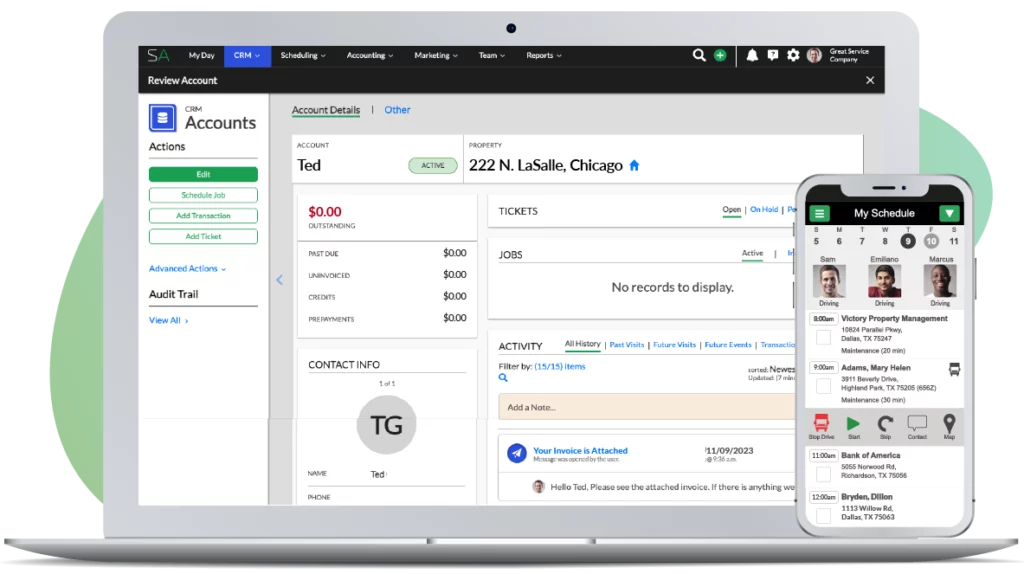“I’m new to the industry. How do I learn to price lawn mowing jobs so that I can win bids and be profitable?”
Pricing is really difficult. When I got started in the business I didn’t have the faintest idea how to price commercial or residential. I was clueless. I remember the challenge and the difficulty. I remember struggling to figure it out.
As I’ve matured in business and learned more, I often say that I do not like copying what other people are doing. I don’t like copying their marketing. I don’t like copying how they run their business. I don’t like copying how they price. However, the reality is, when you don’t know what you’re doing, what else do you do?
Let’s talk about this from a realistic standpoint. I’m going to use mowing as the example but, it could apply to lawn care which is fertilization and weed control, aeration, year long ant treatments, pest control, and irrigation. All these different services.
In your market, and in my example here, most companies start in residential lawn mowing. It’s the easiest one to get started in. Most companies that don’t really know how or have never been in the industry don’t start in commercial. We’ll just use the residential mowing example.
In your market most people charge $50 to mow a lawn. How do you know that? You know that because they’re putting out door hangers and they’re advertising pricing on their website. You just start to figure it out. The mowing is one of the easiest services to figure out what everybody’s charging because they all lead with that in their marketing piece. They talk about price.
Mowing is probably the biggest commodity in lawn care in that price is very easy to figure out and it’s known. Start with figuring out what others are charging. You start to find out what it is and then you pick a midpoint. If you hear that they’re charging 45 to 50 or maybe 55 for this neighborhood, you might start at 50.
It could be a big mistake, but that’s where you start. Ideally you’re not signing contracts with the clients. You’re just signing them up for lawn mowing. If you get it wrong, you can raise their price or you can let them go as a client.
Now let’s use the $50 example. You just pick $50. You don’t know if this is good, you just copied your competition. So day one, you want to start doing this. Most companies don’t do this, but it will make all the difference. When you get to the property you write down the start time and when you get done you write down the stop time.
This job took one and a half hours. 1.5 hours. How much does that mean you’re making? If you charge $50 and you’ve spent one and a half hours to do the job, you’re making $33.33 an hour. You may be happy with that.
Maybe before you were making $40,000 a year at your job which is the equivalent of $20 an hour, so $33 sounds great. The dilemma is, as your business matures and you need to hire people and buy equipment and have somebody in the office, then eventually hire an operations manager, you need to have enough money built in here to pay for all that other stuff.
In the beginning days, it all feels great and wonderful because wow, we’re making a lot of money because you have virtually no cost. Costs will go up as your business grows. The point here, the real value of this is now you’re starting to become aware of the relationship between time and the money earned.
As you pay attention to this, you’ll have a gut feeling on which jobs are good, and which jobs are bad. Why did this job take longer than another? Let me give you an example. You are out eyeballing properties and you get another lead and you price that job. The property’s about the same size, so you price it at $50 as well. You track your start and end time, but the difference here is that it takes two and a half hours.
This two and a half hour job means you’re making only $20 a man hour. Suddenly that doesn’t feel so good because you had fuel and other expenses. Now because you were tracking your time and most people don’t, you are now aware that something’s different here. You start to analyze the job. You start to say okay, why does this job take longer than another?
You start to think about the characteristics of the property. At this property they have a lot more trees. At this property they have a terrace in the front, so that requires more time to get the mowers up there. Then, when we go to the backyard, we have to go back to the front, ring the doorbell, wait for Miss Smith to open the back gate, put up the dog, and let us in.
Whereas, at the other property we can just get in and out of the gate ourselves because we have the gate code. At this yard we have to bag it, whereas at another yard we have to mulch it.
Then, when we’re about to leave, she always comes out and she wants to chat for five or 10 minutes. That’s why it takes two and a half hours. That awareness then tells you a couple things. One, it tells you that just because a yard is the same size does not necessarily mean it’s going to take the same amount of time.
If it’s not going to take the same amount of time, what are the attributes about that property that you might not want more of? You may now want to start avoiding jobs where the client says they’re going to have to let you in the gate, or that you’re going to have to call ahead to meet at a certain time, or the yard has lots and lots of trees. Maybe you don’t want those.
Or, maybe you say you know what? I’ll still take those, but I know they’re going to take me more time. So, to achieve my goal I probably need to charge about $80 an hour there. As you can see, that would make you about $32 an hour.
The tracking of the time is the most important thing because if you’re copying somebody else’s price, which is okay, if you track your time, you start to see where your problems are. Then, you can start increasing prices or you can start to learn from your mistakes and on the next job, price that job correctly.
This works with every service you’ll provide. You can start out modeling the market and then from there you can work on improving the pricing and making it your own. Rule of thumb in my mind, if you’re doing residential, you really want to aim for making a minimum of $40 a man hour.
Now, you could be overpricing yourself in the future if you are not very efficient yet. You don’t really know how to trim bushes very well. You don’t know how to mow yet or you have mowing equipment, but it’s kind of like the Home Depot version of equipment so it really slows you down.
If you aren’t efficient, you may have to earn less than $40 a man hour for a while, until you get the right setup. But, once you’ve got the right tools and you’ve figured out how to do it and you’re quick, you really need to be achieving this man hour rate. My point of telling you the alternative that you may not be able to get that, is if you try to charge $40 a man hour, and you’re using really crummy equipment and you have all these inefficiencies in your business, you may way overprice yourself in the marketplace and not be able to win any business.
I simply am saying that the goal in my mind is you really want to be getting a minimum of 40 an hour. That’s a number that you can grow a business with. This $25, $30 an hour stuff doesn’t work. You’ll see some of that kind of stuff in commercial, but you have to have big properties and tons of volume. You cannot make those types of numbers work with a bunch of residential properties, in my opinion.
That’s the basis of getting pricing figured out in the beginning. Kind of model the market and adjust quickly. Learn from experience.




One Reply to “How To Price Lawn Mowing Jobs When You Don’t Know How”
So useful. I know from experience that doing the same thing over and over again and again will give you the same results. Want a change? then make a change. Thanks!